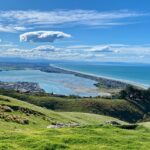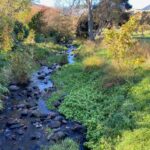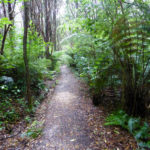Some of Christchurch’s environmental leaders gathered in August 2022 to discuss the critical issues facing our environment in preparation for local elections. Mayoral Candidate David Meates was the special guest. Stories were told of groups around Banks Peninsula and Christchurch working to regenerate the hills, valleys and streams. For example over twenty groups are working […]
Stargazing at Mt John Observatory Tekapo
‘A night with the stars’ according to Graeme Murray one of our guides on the recent Canterbury University Alumni weekend to Mt John observatory, has transformed Tekapo into a bustling ‘must visit’ location in NZ. Graeme regales the group of Alumni with stories of the land.

The Moa Telescope with Lake Alexandrina on left, and Tekapo to the right.
The search for a southern astronomical observatory was initiated by University of Pennsylvania and Tekapo was chosen in 1963 for its air clarity, light-pollution-free skies and lack of cloud cover. Thus began an agreement with University of Canterbury that over the years has extended into other international collaborations which has enabled the building of larger and more powerful telescopes.
Now known as ‘Aoraki Mackenzie International Dark Sky Preserve’, the 4,300 sq km area includes Aoraki Mt Cook National Park and the villages of Mt Cook, Tekapo and Twizel and the designation helps to safeguard this invaluable asset.
The Mt John observatory at Tekapo is recognized as one of the most easily accessible and best sites in the southern hemisphere for viewing the night sky.
Lights that shine down are mandatory and new builds in the dark sky reserve are installing low-pressure sodium lights that are even better. Encourage your city to likewise think of stopping night sky pollution.
So what is the observatory all about?
Untangling the mystery of the universe and its origins e.g. the study of stars and their evolution, finding other planets in other constellations as well as studying near earth objects such as small asteroids.
‘The Tarantula nebula’ is an example of what we looked at on our night at the observatory. It is found in the Large and Small Clouds of Magellan (LMC & SMC). These are two galaxies in the Milky Way. The LMC is about 160,000 light years away (1 light year = 10,000 billion km). The Tarantula nebula is a glowing gas cloud in LMC. The gas glows in the ultra-violet light from a cluster of very hot stars at the centre of the nebula. The cloud is about 800 light years across. This nebula is one of the brightest known and I guess takes its name from its spider shape.
Despite the excitement of the big telescopes, they can’t replace the magic of going outside and lying in the grass and being dazzled by a heavenly dome of stars. That is truly awesome.
Friends have just returned from China (where they could look directly at the sun the haze was so bad). Stars are no longer a part of many people’s experience.
More Astronomers Needed
Astronomers have become short on the ground (or more precisely at the telescopes) at Mt John. Caused by University of Canterbury’s senior staff reaching retirement, a lack of new recruits and funding issues following the Christchurch earthquake.
Earth and Sky Tours
Access to Mt John is now open to the public during the day and at night through the Earth and Sky tours . Thanks to this business partnership the road is kept in good repair, a stunning café has been opened with 360 degree panoramic views of Lake Tekapo, Lake Alexandrina, the Southern Alps and the Mackenzie Basin with its tawny brown tussock colours.
The Roaming Ecologist was particularly concerned about the degraded state of the land not just around the observatory but around Tekapo and Lake Alexandrina. Years of burning, clearing of tussocks and tress that capture moisture was followed by over grazing, drought and the introduction of rabbits that has left much bare ground.
This then becomes the perfect habitat for weeds such as the invasive ground hugging Heiracium which outcompetes the native grasses and other invasive species such as sweet briar rosehip (Rosa rubinginosa).
Moa bones were commonly found around Tekapo by early settlers ploughing the land. Matagouri (Discaria toumatou) is thought to have evolved leathery stems, like thorns, to resist the moa grazing and this is one of the few natives found in abundance in the vicinity.
Our weekend with the stars has raised my awareness as to what a precious resource this is and to appreciate anew those who have worked to set up the ‘Dark Sky Preserve’ for us all to enjoy.











Leave a Reply